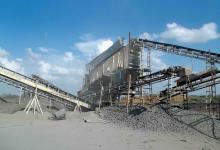India is one of the largest global consumers of aggregates and the new landmark for the world construction industry market.
In 2015 leadership in Asia changed hands, with China falling back in terms of global investments in this sector, achieving only +4% growth while India posted growth of 5.3% over the year.
“The centre of gravity for the construction market over the last 15 years has gradually shifted eastwards, with the proportion of global investments covered by advanced countries down from 70% to 43% in favour of India and China,” says a report by SaMoTer-Verona Outlook.
[caption id="attachment_82731" align="alignright" width="300"] Crushing and screening demand is booming in India[/caption]
Crushing and screening demand is booming in India[/caption]
One of the drivers for the stand-out performance of India’s construction industry is the Make In India programme launched by prime minister Narendra Modi in September 2014. Since its inception, the initiative has reportedly generated more than $63 billion in foreign direct investment, largely directed towards infrastructure development.
International development banks are also making billions available for significant projects, such as road and rail projects, bridges, airports and power plants, and there are plenty of these in the country that markets itself to tourists as “Incredible India”.
A spokesman for specialist market intelligence and forecasting company, Off-Highway Research, said: “The Indian construction equipment industry has experienced almost 20% growth this year [2016], and we are optimistic that it will continue to expand in the coming years, albeit at a more measured pace.
India’s 12th Five-Year Plan (2012-2017) says that investment in infrastructure is the main growth driver of the construction equipment industry, with the Planning Commission estimating that total infrastructure spending will be about 10% of GDP, up from 7.6% in the previous plan (2007- 2012).
Indeed, it has been estimated that infrastructure spending during the current plan will double to about $1 trillion compared to the previous plan. While India has one of the world’s largest road networks, said to be some 5.5 million km in total, only a small proportion of these, estimated at around 2%, are Expressways or National Highways, some of which are already four or six lanes, while others are being upgraded to this status. Expressway construction in India in 2016-17 is expected to grow to 15,000km compared with 6,000km the year before. Many roads are classed as major or other district roads, while the majority are rural and other roads.
And with the spending to upgrade housing and infrastructure, the country’s construction sector is expected to grow at 8%/year for the next decade. All this is good news for those in the construction industry, which employs more than 30 million people, and for quarry and mine owners who will have to supply vast amounts of materials, including aggregates, to complete the projects.
[caption id="attachment_82733" align="alignleft" width="300"] Technologically advanced crushing and screening equipment increases productivity[/caption]
Technologically advanced crushing and screening equipment increases productivity[/caption]
Indeed, a report by the Working Group on Mineral Exploration and Development (other than coal and lignite) for the 12th Five-Year Plan, noted: “The country is endowed with huge resources of many metallic and non-metallic minerals.
“The mining sector is an important segment of the Indian economy. India produces as many as 87 minerals, which include fuel, metallic, non-metallic, atomic and minor minerals (including building and other materials).”
It also noted: “The Indian dimension stone industry is totally dependent on road transport with practically no support from the railways. “Most of the competing countries have a vast network of rail transportation supporting their stone industry through which they are able to offer any quantity in any size at very competitive prices in the international market.
Thus, it is necessary for the Indian stone industry to have proper rail links nearest to the quarrying areas.” The report also called for special studies to be conducted on sand, sand resources, and sand substitutes including M-sand (crushed aggregates).
India’s first SmartCity project at Kochi is expected to cost $1 billion while the Navi Mumbai International Airport project is scheduled for completion in 2019. The Gujarat International Finance Tec-City is another smart city on 3.6km² of land, and the 359m tall railway bridge over the River Chenab currently under construction, will be the highest railway bridge in the world when completed.
The full version of this article was first published in Aggregates Business International





